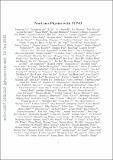Neutrino physics with JUNO
Author(s)
Conrad, Janet Marie
DownloadNeutrino physics with JUNO.pdf (6.997Mb)
OPEN_ACCESS_POLICY
Open Access Policy
Creative Commons Attribution-Noncommercial-Share Alike
Terms of use
Metadata
Show full item recordAbstract
The Jiangmen Underground Neutrino Observatory (JUNO), a 20 kton multi-purpose underground liquid scintillator detector, was proposed with the determination of the neutrino mass hierarchy (MH) as a primary physics goal. The excellent energy resolution and the large fiducial volume anticipated for the JUNO detector offer exciting opportunities for addressing many important topics in neutrino and astro-particle physics. In this document, we present the physics motivations and the anticipated performance of the JUNO detector for various proposed measurements. Following an introduction summarizing the current status and open issues in neutrino physics, we discuss how the detection of antineutrinos generated by a cluster of nuclear power plants allows the determination of the neutrino MH at a 3–4σ significance with six years of running of JUNO. The measurement of antineutrino spectrum with excellent energy resolution will also lead to the precise determination of the neutrino oscillation parameters sin² θ₁₂, Δm₂₁² and |Δm[subscript ee]²| to an accuracy of better than 1%, which will play a crucial role in the future unitarity test of the MNSP matrix. The JUNO detector is capable of observing not only antineutrinos from the power plants, but also neutrinos/antineutrinos from terrestrial and extra-terrestrial sources, including supernova burst neutrinos, diffuse supernova neutrino background, geoneutrinos, atmospheric neutrinos, and solar neutrinos. As a result of JUNO's large size, excellent energy resolution, and vertex reconstruction capability, interesting new data on these topics can be collected. For example, a neutrino burst from a typical core-collapse supernova at a distance of 10 kpc would lead to ~5000 inverse-beta-decay events and ~2000 all-flavor neutrino–proton ES events in JUNO, which are of crucial importance for understanding the mechanism of supernova explosion and for exploring novel phenomena such as collective neutrino oscillations. Detection of neutrinos from all past core-collapse supernova explosions in the visible universe with JUNO would further provide valuable information on the cosmic star-formation rate and the average core-collapse neutrino energy spectrum. Antineutrinos originating from the radioactive decay of uranium and thorium in the Earth can be detected in JUNO with a rate of ~400 events per year, significantly improving the statistics of existing geoneutrino event samples. Atmospheric neutrino events collected in JUNO can provide independent inputs for determining the MH and the octant of the θ₂₃ mixing angle. Detection of the 7Be and 8B solar neutrino events at JUNO would shed new light on the solar metallicity problem and examine the transition region between the vacuum and matter dominated neutrino oscillations. Regarding light sterile neutrino topics, sterile neutrinos with 10⁻⁵eV² < Δ m₄₁² < 10⁻²eV² and a sufficiently large mixing angle θ₁₄ could be identified through a precise measurement of the reactor antineutrino energy spectrum. Meanwhile, JUNO can also provide us excellent opportunities to test the eV-scale sterile neutrino hypothesis, using either the radioactive neutrino sources or a cyclotron-produced neutrino beam. The JUNO detector is also sensitive to several other beyondthe-standard-model physics. Examples include the search for proton decay via the p [arrow to] K⁺ + [bar ν] decay channel, search for neutrinos resulting from dark-matter annihilation in the Sun, search for violation of Lorentz invariance via the sidereal modulation of the reactor neutrino event rate, and search for the effects of non-standard interactions. The proposed construction of the JUNO detector will provide a unique facility to address many outstanding crucial questions in particle and astrophysics in a timely and cost-effective fashion. It holds the great potential for further advancing our quest to understanding the fundamental properties of neutrinos, one of the building blocks of our Universe.
Date issued
2017-04-28Department
Massachusetts Institute of Technology. Department of PhysicsJournal
Journal of Physics G: Nuclear and Particle Physics
Citation
An, Fengpeng; An, Guangpeng; An, Qi; Antonelli, Vito; Baussan, Eric; Beacom, John; Bezrukov, Leonid et al. “Neutrino Physics with JUNO.” Journal of Physics G: Nuclear and Particle Physics 43, no. 3 (February 11, 2016): 030401.
Version: Original manuscript
ISSN
0954-3899
1361-6471